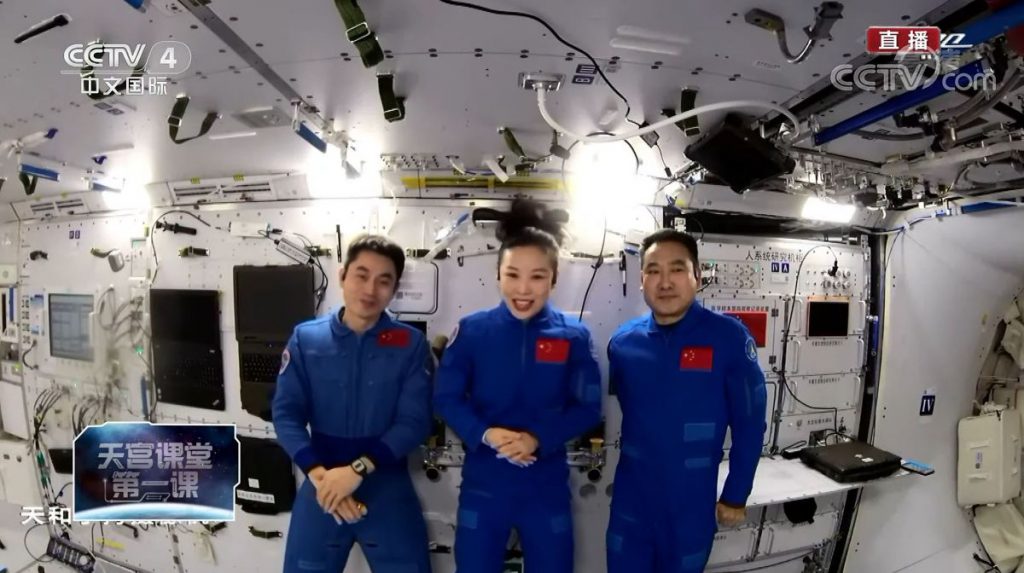
China’s record-setting Shenzhou 13 crew preparing for mid-April return to Earth (Image Credit: Space.com)
China’s three Shenzhou 13 astronauts are preparing to return to Earth after a national record six-month-long mission in orbit aboard the Chinese space station.
Commander Zhai Zhigang, Wang Yaping and Ye Guangfu launched on Shenzhou 13 from Jiuquan in the Gobi Desert on Oct. 15, 2021, docking with the still-under-construction Chinese space station hours later.
The trio have since completed two extravehicular activities — or spacewalks — delivered a pair of science outreach lectures and carried out more than 20 scientific experiments related to studies of life sciences and more during their nearly six months in orbit.
Related: The latest news about China’s space program
They will have spent 167 days in space aboard the station’s core Tianhe module by the end of March and are expected to complete their mission at around the 180-day mark. Before leaving, however, they will prepare Tianhe for the arrival of its next crew, launching on Shenzhou 14 in the coming months.
“Before leaving, there are a lot of materials that need to be sorted out, including those packages and products on Tianzhou 3,” Zhong Weiwei, an associate research fellow at the Astronaut Center of China, told China Central Television (CCTV), referring to a cargo spacecraft that launched to the Chinese space station in September.
“The crew of Shenzhou 14 will come up more than a month after the Shenzhou 13 crew’s return, so these products and equipment should be put in place in advance,” Zhong said, adding that a number of important samples are to be brought back from space.
China has not yet announced a date for the crew’s return to Earth, but Zhou Jianping, chief designer of China’s human spaceflight program, told Chinese press on March 4 that they would come home in mid-April.
Shenzhous 13 has set a number of Chinese records. The country’s previous national record for human spaceflight mission duration was set by last year’s Shenzhou 12 mission, which lasted 92 days.
Wang became the first woman astronaut aboard Tianhe and the first Chinese woman to embark on a spacewalk.
The mission has also highlighted how China’s ruling Communist Party has been seeking to use the space station for domestic legitimacy.
Molly Silk, a doctoral researcher of Chinese space policy at the University of Manchester in England, told Space.com recently that the live science lectures aim to underline China’s progress and inspire interest in science.
“A real-time, interactive event with China’s taikonauts highlights the reality of the country’s technological achievements and displays the competencies and utility of its space program,” Silk said. “Such an event serves to enhance national pride and to encourage young citizens to pursue science-based careers.”
The live lecture audiences specifically included students from provinces and regions from the country’s periphery, including Hong Kong, Macau, Tibet and Xinjiang.
The space station and the astronauts also featured in solar New Year and Lunar New Year celebrations, highlighting that China now has its own, permanent crewed presence in orbit just like the International Space Station.
Meanwhile, the crewmembers are continuing their preparations for a return to Earth, including physical exercise regimens.
“Based on the data obtained from their physical in-orbit examination, we have made targeted adjustments to the entire protection plan before their return. In fact, the focus at this stage is on guaranteeing [the astronauts’] physical exercise to prepare for a safe landing and safe return,” Zhong told CCTV.
When it does leave space, the Shenzhou 13 return capsule will be deorbited for a landing near Dongfeng in the Gobi Desert, Inner Mongolia, close to the Jiuquan Satellite Launch Center from which it lifted off.
China is planning two crewed missions, Shenzhou 14 and Shenzhou 15, in 2022. China aims to add two further modules to Tianhe this year, meaning that the completed, three-module space station will be able to host both of these three-astronaut crews for a short time and complete a first crew handover of the station late in the year.
Follow us on Twitter @Spacedotcom or on Facebook.






